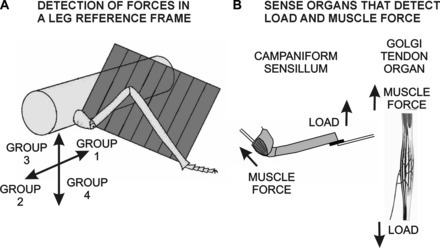Fig. 9.

Model of force detection and control. A: frame of reference. Our findings suggest that the trochanteral sensilla are organized to supply information about the vectorial direction of loads relative to the plane of leg movement. Trochanteral Group 3 receptors show the largest discharge to forces applied dorsally in the leg plane, while Group 4 sensilla respond to ventral forces. Previous tests have demonstrated that the Group 2 receptors encode forces in an anterior direction, while Group 1 discharge to posterior forces. Thus the plane of joint movement forms a frame of reference for information about forces acting on the leg. B: campaniform sensilla share properties of other force receptors. Both campaniform sensilla and Golgi tendon organs encode muscle forces. Detection of load depends upon the presence of muscle tensions.
